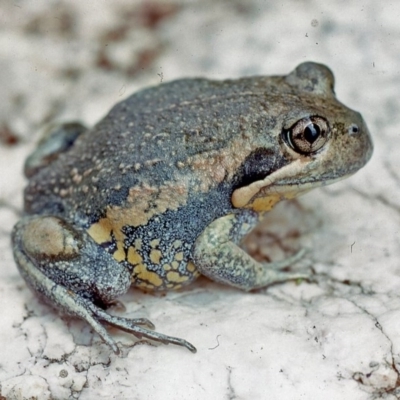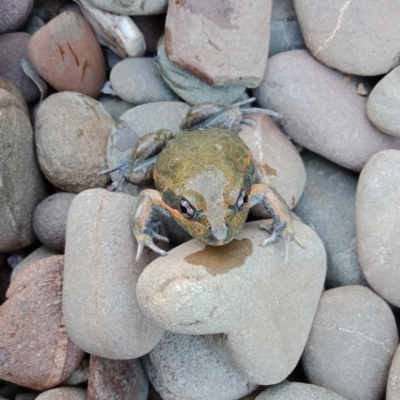Limnodynastes dumerilii (Eastern Banjo Frog)
Eastern Banjo Frog, also known as Pobblebonk or Four-bob Frog, is a common and widespread burrowing frog may often be found in large numbers at night, particularly after rain. Adult length: 50-85mm
Current conservation status: Common, possibly declining.
Distribution: Mostly found in northern ACT; widespread below 1200 m.
Family: Myobatrachidae
Appearance: They are grey-brown in colour and have a white granular stripe from below the eye to above the base of their front leg and a broad, dark band from the eye to the "ear". The legs are thick-set. There is a large raised lump on the outside of each thigh and on the underside of each foot for digging.
Length: Up to 85mm
Breeding: Breeds from September to early January, particularly after heavy rain.
Habitat: This species is rarely seen because for much of the time they remain hidden in short burrows in the ground. However, on wet summer evenings they may be observed sitting on the road surface. They are often discovered in soil deliveries to urban gardens as they have a habit of burrowing into soft soil.
Distribution: Widely distributed and common throughout lowland areas in the region and south-eastern Australia. In the ACT mostly found in the northern parts.
Biology: Females lay up to 4,000 eggs in a conspicuous, floating, foamy mass with a diameter of about 12-18cm. The tadpoles are large and easy to identify because of their light brown colouration and the presence of numerous pale blotches on the tail. In high altitude, tadpoles can take up to two summers to reach metamorphis.
Call: Their call sounds like a deep, slow repeated "thud"or "bonk" when calling from the water, or a loud "toc" if calling from land.
Limnodynastes dumerilii is listed in the following regions:
Canberra & Southern Tablelands | Southern Highlands | Albury, Wodonga | South Coast | Central West NSW | Riverina Murray | New South Wales North Coast | Hume | Barwon South West | Loddon Mallee
Species information
- Limnodynastes dumerilii Scientific name
- Eastern Banjo Frog Common name
- Not Sensitive
- Local native
- Non-invasive or negligible
- Up to 1550.52m Recorded at altitude
- 150 images trained Machine learning
Location information
-
Maps
ANBG ANU Banks Precinct ANU Dickson Precinct ANU Garran Precinct Aranda Bushland Australian National University Banksia Street Wetland Corridor Barracks Flat Drive Reserve Bendora Reservoir Birrigai Black Mountain Bluetts Block (402, 403, 12, 11) Bruce Ponds Bruce Ridge to Gossan Hill Bullen Range Callum Brae Canberra City Farm Central Molonglo Commonwealth & Kings Parks Conder Community Wetlands Cooleman Ridge Cooma North Ridge Reserve Coombs Ponds Coornartha Nature Reserve Cotter Reserve Dangelong Nature Reserve Dickson Wetland Dickson Wetland Corridor Dunlop Grasslands Fadden Hills Pond Farrer Ridge Gang Gang at Yass River Gibraltar Pines Gigerline Nature Reserve Ginninderry Conservation Corridor Giralang Wetlands Googong Foreshore Googong Reservoir Gossan Hill Goulburn Mulwaree Council Gundaroo Common Gungaderra Grasslands Gungahlin Pond Holder Wetlands Illilanga & Baroona Isaacs Ridge Isaacs Ridge and Nearby Isabella Pond Jarramlee Pond Jarramlee-West MacGregor Grasslands Jerrabomberra Grassland Jerrabomberra Wetlands Kowen Escarpment Lake Ginninderra Lake Tuggeranong Lanyon - northern section A.C.T. Lions Youth Haven - Westwood Farm A.C.T. Lower Cotter Catchment Lower Molonglo McKellar Wetlands Molonglo Gorge Molonglo River Reserve Mongarlowe River Mount Ainslie Mount Ainslie to Black Mountain Mount Majura Mount Taylor Mulligans Flat Nadjung Mada NR Namadgi National Park National Arboretum Forests Percival Hill Point Hut Pond Point Hut to Tharwa Rob Roy Range Stony Creek Stranger Pond Sullivans Creek, Acton Swamp Creek The Pinnacle The Ridgeway Reserve Tidbinbilla Nature Reserve Tuggeranong Creek to Monash Grassland Tuggeranong Hill Tuggeranong Pines Umbagong District Park University of Canberra Upper Stranger Pond Urambi Hills Uriarra Recreation Reserve Wanniassa Hill Watson Green Space West Belconnen Pond West Stromlo Woodstock Nature Reserve Yarramundi Grassland Yass Gorge Yerrabi Pond -
Survey points
AMA100: Amaroo Pond ANB100: ANBG pond ANU012: Dickson/Clunies Ross DAM ANU019: Sullivans Ck Daley Rd/Ward Rd ANU020: Sullivans Creek Stepping Stones, Adjacent to Building 46. ANU042: Constructed pond, adjacent to Dickson Rd Carpark, Acton ARA100: William Hovell/Bindubi ARA200: Bindubi St Gate BAD200: Badja River below Maggies Xing BAD600: Badja River at Braidwood Road BAR020: Barracks Ck Dam 1 BAR050: Barracks Ck Dam 2 BAR200: Doyle Reserve N BAR201: Doyle Reserve S BIL100: Billabong Pond, Watson BIN100: Farm dam Little Burra BLU300: Condor Ck upstream BMT100: Black Mtn SW Dam BON100: Stranger Pond, Bonython BON200: Stranger Pond Bonython at BBQ shelter BON300: Upper Stranger, Bonython BRA100: Bradleys Creek, Upstream BRA200: Bradleys Creek, Downstream BSF127: Black Sally Flat BSW001: Banksia St Wetland BUN100: Elmslea water quality ponds, Bungendore BUN200: Elmslea Estate Pond, Bungendore BUR600: Burra Creek CAP200: Butterfield Property Site B Dam CAP400: Molonglo River, Captains Flat south CAV100: Caves Quarry Dam CBR001: Callum Brae 1 CBR002: Callum Brae 2 CBR003: Callum Brae 3 CBR004: Callum Brae 4 CCG050: Double Dam CEQ200: Equestrian Park 2 CFR100: Molonglo River on Reynolds property, near Balcombe Hill CFR200: Hodgman's Large Dam CFR300: Molonglo off Capt Flat Rd CGH050: Hospital Ck 1, Namadgi CMC100: Cooleman Ridge Dam CMC600: Mt Neighbor Dam CMM200: Gordon Stormwater Pond CMM350: Downriver from Lanyon Homestead CMM900: Murrumbigee River at Mittagang Road Xing CMW500: Weston Creek Sediment Pond- former cross pollutant trap CMW510: 50m downstream from CMW500 COB010: Cooma Back Ck confluence COB011: Cooma Back Ck Kerwan St COB012: Cooma Back Ck Showground COB013: Cooma Back Ck @ Coolamatong CON002: Condor Ck Near Pines CON100: Conder Wetland A CON110: Conder Wetland B COO001: Frog pond at Koskinan Property COO002: Dam at Koskinan Property COO300: Cooma Ck @ Mittagang Xing COO350: Cooma Ck @ North Ridge COO400: Cooma Ck/Cooma Back Ck1 COO405: Cooma Ck/Cooma Back Ck2 COO580: Cooma Ck @ Skatepark COO610: Cooma Ck Egan St COO615: Cooma Ck Albert St COO625: Cooma Ck Banksia Ln COO650: Cooma Ck @ Woodvale COT100: Cotter Camp Ground CRW001: Crace Wetland Pond 1 CTP450: Murrays Corner CTP500: Tanners Flat Ck CTP510: Tidbinbilla River CTT100: Lower Tuggeranong Ck CTT300: Upper Tuggeranong Ck DGP001: Dunlop Grasslands Dam DIW100: Dickson Wetland DUF300: Bushfire Memorial Dam FAD100: Fadden Hills FAD300: Wanniassa Hills Dam FAR001: Farrer Ridge 1 FAR002: Farrer Ridge 2 FBM100: Glenloch Dam FBM200: Black Mtn Storage Yard FBM400: Black Mtn Belconnen Way FBP001: W-Belconnen Pond FER100: Fernhill Park, Bruce FER200: Fernleigh Park at Jerrabomberra Creek Bridge FGB001: Hollows Crescent FGB002: Refshauge Crescent FGC006: Ginninderra Creek at Spain Place footbridge, Evatt FGC007: Ginninderra Creek, at Ginninderra Drive, Flynn FGC009: Jarramlee Pond FGC010: Lake G/College Ck FGC015: Lawson Stormwater Pond FGC020: College Ck, Lawson FGC029: Fassifern Pond FGC030: Gooromon Ponds Ck FGC031: Ginninderra/Gooromon Ponds Ck FGC040: Diddums @ Lake G FGC050: UC Pantowara Rd FGC090: Ginninderra Ck, Macgregor FGC091: Crago Place Billabong FGD005: John Knight Park FGD030: AIS, Drain near bike path FGD035: AIS Wetland FGD040: Aranda Bushland Dam FGG010: Giralang Pond FGW100: Umbagong Eastern Boardwalk FGW150: Umbagong Park, Latham Western Boardwalk Bog FGW200: Latham, Herron Creek FLO200: Stormwater drainage channel, cnr Ginninderra Drive and Kingsford Smith Drive, Florey FMC010: Pinnacle Dam FMC020: QBN River @ Barracks Flat FMC040: Buttles Ck 1 QBN FMC045: Buttles Ck 2 QBN FMC050: Michelago Creek, Huy property FMC140: Mt Majura drainage line, middle. Rocky section. FMC200: Mt Majura 1 Lower FMC210: Mt Majura 2 Upper FMC220: Mt Majura 3 Jukes FOR001: Forde Wetland FOR002: Forde Pond FRA200: Edlington St Pond, Fraser FRA201: Halls Ck, Fraser FTB010: Bogong Ck FTD010: TNR Top Weir/Brolga Pond FTD015: TNR Vets Centre FTD120: TNR Boardwalk FTD160: Tidbinbilla Nature Reserve, Barbeque Swamp FTD165: TNR Bottom Dam FTD200: Tidbinbilla Nature Reserve, Flints(?), large dam at top FTD220: TNR Sheedys Picnic Area FTD250: Tidbinbilla Nature Reserve, Flints(?), smaller dam at bottom FTP100: Isabella Pond FTR020: Cotter Flats upper Cotter GAR200: Garuwanga site 2, hooded robin dam, Nimmatabel GAR300: Garuwanga site 3, Kydra River, Nimatabel GAR400: Garuwanga site 4, Winnifred Creek, Nimatabel GCC100: Condor Ck Brindabella Rd GFW002: Nicholls, Stormwater drain into Gungahlin Pond GFW005: John Knight Park - top pond GFW008: Kippax Creek very close to KIP001- GIN002: Ginninderra Ck, Amaroo GIN007: Ginninderra Ck @ Barton Hwy GIN024: Umbagong Stepping Stones GOG001: Googong Dam, Tin Hut Dam GOG002: Googong Dam, Willow Crossing GOG005: Googong Burra Creek, Homestead Crossing GUN002: Gungahlin Pond Lexcen Ave GUN100: Valley Ponds W/Scout Hall GUN600: Gundaroo Native Forest, Small Dam HAL001: Halls Creek @ Showground HAL002: Halls Creek, Pony Club, Hall HAL005: TSR Dam W of Barton HWY HAL011: Halls Creek Showgroud Bridge - North HOL110: Holder Wetlands ICH001: Illoura Paddock Dam ISA100: Long Gully Rd/Mugga Lane JBD100: John Bisset Property Farm Dam No1, larger than No2 JBD200: John Bisset Property Farm Dam No2, smaller than No1 JBT001: Melba Wetland @ BMX JER010: Jerrabomberra Creek Old Cooma Rd JER020: Jerrabomberra Ck Lanyon Dr JER100: Jerrabomberra Creek at Barrett's JER500: JWs - Kellys @ Bittern Birdhide KIP001: Kippax Ck, Holt LDM100: Lookout Dam, Holt LEE001: Lees @ Rock Groynes LEE002: Lees @ Road-xing LWR100: Little Whiskers Rd River LWR200: Briar Sharrow Bridge MCW001: McKellar Wetland 1 MCW002: McKellar Wetland 2 MCW010: Frog highway, drainage line between 2 McKellar wetlands MFL001: First pond from entrance MFL002: 2nd Pond from Entrance MFL003: Shearing Shed Dam MFL004: Mulligans Flat Site 4 MFL005: 250m N of Woolshed MFL007: Mulligans Flat 7 MFL009: northern section of park MFL010: North side of Sutton Road MFL011: Largest Dam South MFL013: SE Dam Near Bird Site 7 MFL014: Far East dam MFL015: East side of Mulligans Flat MFL017: Eastern Reserve 2 MFL018: In gully at foot of hill MFL055: pond near MFL005 MGC100: Murrumbidgee Golf Course MIR100: Amaroo Ginninderra Ck MND100: Dam on Nixon Property MOL150: Molonglo River, at Molonglo River Park MOL250: Clos Crossing MOL360: Happy Point MOL400: Coppins Crossing MOL450: Molonglo River downstr MOL602: Beard Ck 1 MOL609: Molonglo River Upstream Old Bridge on Yass Rd Qbyn MTC051: Boboyan Rd Bridge MTC121: Mt Clear Campground MTC122: Boboyan Rd Grassy Ck MUR100: Top dam on Lewis property, Gang Gang, Murrumbateman MUR200: Chain of ponds on Lewis property Gang Gang, Murrumbateman MUR250: Lake Kevin MYA050: Yarralumla Ck MYA100: Yarralumla Ck, Curtin Oval MYR300: Top dam at Myrtle Rise, Hall NAA100: Naas River causeway, Caloola Farm NPG100: Gundaroo Common North NRF052: Naas Valley Fire Trail 2 NRF055: Naas Valley Fire Trail 1 NUM050: Numeralla River Stokes’ Xing NUM060: Kybeyan River at Numeralla River confluence NUM070: Numeralla River below Kybeyan River confluence NUM080: Numeralla River below Badja River confluence NUM100: Numeralla River PP Board Xing NUM220: Numeralla River at Murrumbidgee River confluence NUM999: Lake Numeralla ORA001: Orana School Drainage Gully ORA002: Orana School Dam ORR010: Orroral Valley Treatment Pond ORR054: Orroral Valley Day Visitor Park ORR100: Orroral Valley Rock waterfall Stream OSR001: Dam 1 Front gate OSR002: Dam 2 OSR003: Dam 3 Big back dam OSR005: Dam 5 Hidden Dam OSR006: Dam 6 PAR100: Parsons Property, Molonglo River at house. PAR200: Parsons Property, Molonglo River Site 2 PCF000: Cotter @ Thompsons Flat PCF001: Pierces Creek dam PCF002: Pierces Creek PCF003: Pierces Ck Near Sediment Side PIN100: Pinnacle Dam, Hawker PIP010: Pipeline Creek Reserve, Jerrabomberra PLM200: Laver Farm Dam 2 PLM300: Laver Farm, Gully Dam PLM310: Laver Farm, Gully Dam - 100m upstream from PLM300 PLM400: Laver Farm Dam 3 (on adjacent property) PNG100: Pinenut Grove House Dam PNG300: Driveway Dam, Pinenut Grove QBN010: Lonergan Drive, Greenleigh QBN430: Montgomery creek low bridge over Queanbeyan River QBN450: QBN River @ Doeberl 1 QBN455: QBN River @ Doeberl 2 QBN465: QBN River Downstr @ Dane St QBN466: QBN River Upstr @ Dane St RBG001: Redbrow Gardens Lake RCD001: Rose Cottage Paddock 8 RCD002: Rose Cottage Paddock 7 SFF100: Stromlo Forest Dam, Coombs STI100: Molonglo River at Murrumbidgee STP100: Strathnairn Main Pond STR100: Strathhearn Dam, Gundaroo STW003: Florey Stormwater Drain, Melba SUT100: Dam 1, Macrorrhyncha, Moseley Property, Sutton SUT200: Amungula Creek, Gambles TSR SWA100: Fellows Pond, Ginninderra Crk TAL001: Tallulah Dam 1 TAY200: Mt Taylor 2 TGC100: Glendale Crossing TGC300: Upper Gibralter Creek TGN200: Gudgenby River below Naas Xing TMC100: Middle Creek TMC110: Bogong Ck @ New Gate TOR100: Orroral River Campsite TRA100: Travica property TRC100: Rendevous Creek TUG100: North-East Lake Tuggeronong UCM300: Mulligans Flat UC Site 3 UHD015: Urila Home Dam UMB100: Ginninderra Crk, Umbagong Carpark UMD004: Tharwa Sandwash UMD005: Point Hut Crossing, Gordon UMS002: Scottsdale Gungoandra Ck @ Ford WAM001: Wamboin Community Centre Dam WAM003: Sylvia's Dam WAM004: CEASED!!!!! Sally's Dam WAM005: Merran's Pond, Bywong WAN001: Dam at 232 Wanna Wanna Road WEE004: Weetalabah - site 4 WEE100: Weemalla Sarah's Wallaroo site WIS100: Wisewood Dam, Gundaroo XER001: Bottom Pond, CIT Weston XER002: Top Pond, CIT dept of Horticulture, Weston XER003: Middle or Large Pond, CIT dept of Horticulture YAS100: Miles Franklin Park, Yass YRR100: Yass River Reserve -
Places
Acton, ACT Amaroo, ACT Binjura, NSW Bonner, ACT Bonython, ACT Booth, ACT Bredbo, NSW Bungendore, NSW Burra, NSW Bywong, NSW Canberra Central, ACT Captains Flat, NSW Carwoola, NSW Chakola, NSW Conder, ACT Cooma, NSW Coombs, ACT Cotter River, ACT Countegany, NSW Crace, ACT Curtin, ACT Dickson, ACT Dunlop, ACT Evatt, ACT Fadden, ACT Florey, ACT Forde, ACT Fraser, ACT Fyshwick, ACT Giralang, ACT Glen Fergus, NSW Googong, NSW Gordon, ACT Greenleigh, NSW Greenway, ACT Gundaroo, NSW Gungahlin, ACT Hackett, ACT Hall, ACT Holder, ACT Hume, ACT Isaacs, ACT Isabella Plains, ACT Jerrabomberra, ACT Jerrabomberra, NSW Kambah, ACT Karabar, NSW Kowen, ACT Latham, ACT Lawson, ACT Macgregor, ACT Majura, ACT Marchmont, NSW McKellar, ACT Michelago, NSW Molonglo Valley, ACT Monash, ACT Mount Clear, ACT Nanima, NSW Ngunnawal, ACT Nicholls, ACT Nimmitabel, NSW Numeralla, NSW O'Connor, ACT Paddys River, ACT Queanbeyan East, NSW Queanbeyan, NSW Rendezvous Creek, ACT Rose Valley, NSW Royalla, NSW Springrange, NSW Strathnairn, ACT Stromlo, ACT Sutton, NSW Symonston, ACT Tallong, NSW Theodore, ACT Throsby, ACT Tuggeranong, ACT Uriarra Village, ACT Urila, NSW Wallaroo, NSW Wamboin, NSW Watson, ACT Weston, ACT Whitlam, ACT Winifred, NSW Yarralumla, ACT Yarrow, NSW Yass River, NSW Yass, NSW Young, NSW
















































































































































